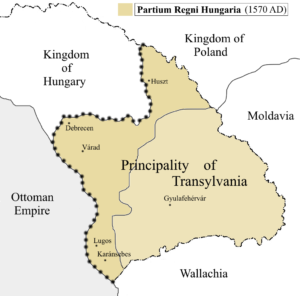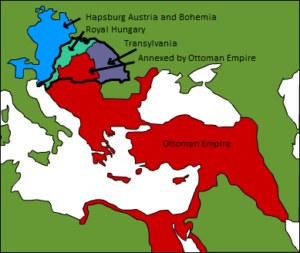6 October 1636 Prince Rákóczi scatters the army of the Pasha of Temesvár at Nagyszalonta

The political situation
The aging Bethlen István, the younger brother of the late Prince Bethlen Gábor, just couldn’t accept the loss of his throne that happened in 1630. Using his excellent Ottoman connections, he fled to Buda and began spreading the lie that Prince György Rákóczi wanted to cede Transylvania to the Habsburgs. You can learn more about Catherina Brandenburg’s role in this plotting because the young widow of Prince Bethlen Gábor also had a hand in it:
https://www.hungarianottomanwars.com/essays/catherine-of-brandenburg-wife-of-prince-bethlen/

My remark: The Dutch agents in Istambul were also instigating the Sultan against the Transylvanians in the hope of war would eventually break out between the Habsburgs and the Ottomans, as a bonus of the Transylvanian conflict. Being knee-deep in the 30-year-war, they wanted to split the Habsburgs’ forces this way; and they didn’t really care that they were betraying their ally, the Calvinist Rákóczi by this. Let us make a short detour to see about this and let us read Cardinal Pázmány’s letter to King Ferdinand about the Dutch intentions.

The letter of Pázmény Péter to King Ferdinand





Rákóczi turns against the Sultan
As we can see, Cardinal Pázmány Péter also thought the Prince’s situation hopeless, despite he offered Rákóczi his support. Finally, Rákóczi had decided to fight against the Sultan, like the young Prince Báthory Gábor two decades before him. Rákóczi has done his best according to his circumstances. He didn’t have much chance for hiring mercenaries in the middle of the 30-year-war. Yet, he guessed that the Turks wouldn’t be able to send a more serious army against him because they were busy in Asia. He thought they would send troops only from the Occupied Lands of Hungary.

The Prince’s ally was Matei Brancoveanu, Voivode of Wallachia, who was protecting his back. The Prince ordered Ibrányi Mihály, the vice-captain of Várad (Oradea) castle, to call the Hajdú soldiers to arms. Rákóczi had to know that he would need to be able to resist only until the day of Kaszim, the end of October, which has always marked the end of the Turks’ campaigns.

Meanwhile, the Sublime Porte was offering its support to him but he didn’t believe it at all. The Prince wrote this to the Ottoman kaymakam, “lieutenant-governor” the next:
“Everybody could learn from this, how one should trust the Turks, because if someone put his faith in them, indeed, would be disappointed like a dog.”
The military conflict
The usurper Bethlen István summoned the Hajdú soldiers to join him on 12 September at Rákos Field near Buda. He was accusing Rákóczi of having committed cruelty and lawlessness. We can learn from Prince Rákóczi’s letter, though, that the Hajdú soldiers had remained faithful to him. Rákóczi summoned his army to Torda and the Hajdú soldiers of Bihar had to gather at Szalonta (Nagyszalonta). Kornis Zsigmond, the chief captain of Transylvania, has brought the Székely army there, too. You can read more about the Hungarian Székely Border guards of Transylvania on my page:
https://www.hungarianottomanwars.com/essays/who-were-the-szekelys/
Rákóczi was able to bring together the entire military power of Transylvania under his flags, altogether 18,000 men. The army of his enemy consisted of troops from all over the Ottoman Occupied Lands and couldn’t be more than 15,000 soldiers. Hussein, the Pasha of Buda, sent the Begler Bey of Temesvár castle against the Hajdú soldiers at (Nagy)Szalonta to cut them off from the rest of the Transylvanian army.

The Hajdú soldiers of Ibrányi fled the battle and ran until Várad but there was a seasoned Hajdú warrior who approached the Turkish camp with a few men in secret in the evening of 6 October and ambushed them. Their fearsome battle cry “hujj, hujj, rá!” (hurray, hurray, at them!) sounded like the howl of wolves, causing fright in the Ottoman army. Panic broke out among the enemy who began to flee. Strange enough, both the Ottomans and the troops of Ibrányi thought themselves defeated.

During this time the army of the Pasha of Buda was staying in camp on the field near Gyula castle. He wrote a letter from here to Rákóczi in which he demanded the Prince’s surrender. The Prince has also disregarded this letter like he had done the same with the previous pherman of the Sublime Port in which the Sultan had dethroned him. The Pasha of Buda wanted to enter Transylvania along the River Maros but Rákóczi went before him to force a decisive battle at him at Borosjenő. He was so sure of his success that he had brought along his two sons, György and Zsigmond as well.
He was preparing himself for the battle when a chiaus (an Ottoman officer) was led to him who volunteered to act as a negotiator between the parties. Both the Pasha and the Prince took the offer happily because both of them wanted to back out from this unpleasant and senseless conflict, without losing face. To understand better the relations between the Ottomans and Transylvania, please read the summary I made, based on the lecture of Balla Péter:
https://www.hungarianottomanwars.com/essays/transylvanian-principality-a-vassal-state-of-the-turks/

Thus they reached an agreement on 6 October that we call the Truce of Borosjenő. The Truce reinforced the Prince in his title. Obviously, the Pasha had been very much surprised at the strong Transylvanian resistance and Rákóczi’s resoluteness. It contradicted the gossip spread by Bethlen István who had said that everybody hated Rákóczi and the Transylvanians were hardly waiting to get rid of him. Despite this, the reality was that the noble orders had lined up next to Rákóczi and the triumph at Nagyszalonta over the Turks also greatly contributed to reaching an agreement. After this, nobody threatened Rákóczi’s throne anymore and the Prince made peace with even Bethlen István, too.

My conclusion: it can be clearly seen that Transylvania represented a considerable power during Prince Rákóczi I György’s reign and the Ottoman Turks could not have as much influence as before. You can read more about the deeds and the life of Rákóczi György here:
Sources: Szibler Gábor and Szerecz Miklós, the Latin translation was done by Téglásy Imre
Dear Readers, I can only make this content available through small donations or by selling my books or T-shirts.
If you like my writings, please feel free to support me with a coffee here:
You can check out my books on Amazon or Draft2Digital, they are available in hardcover, paperback, or ebook:
https://www.amazon.com/dp/198020490X
or at https://books2read.com/b/boYd81


My work can also be followed and supported on Patreon: Become a Patron!http://Become a Patron!


https://hungarianottomanwars.myspreadshop.com/

https://hungarianottomanwars.myspreadshop.com/all


